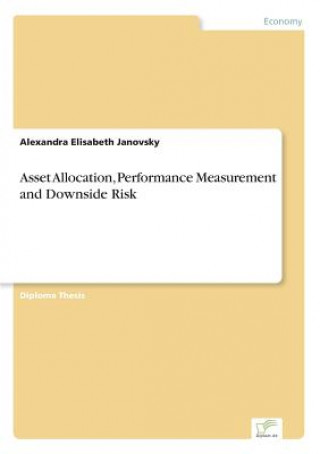
Livrare
Consilier de cumpărături





Nu se pretează? Nu contează! La noi puteți returna bunurile în 30 de zile
 Voucher cadou
orice valoare
Voucher cadou
orice valoare
Cu un voucher cadou nu veți da greș. În schimbul voucherului, destinatarul își poate alege orice din oferta noastră.
Asset Allocation, Performance Measurement and Downside Risk
 engleză
engleză
 268 b
268 b
30 de zile pentru retur bunuri
Ar putea de asemenea, să te intereseze


Diploma Thesis from the year 2001 in the subject Business economics - Investment and Finance, grade: 1,0, University of Vienna (unbekannt, Betriebswirtschaftslehre), language: English, abstract: Inhaltsangabe:Abstract:§Investors should not and in fact do not hold a single asset, they hold groups or portfolios of assets. An important aspect in portfolio theory is that the risk of a portfolio is more complex than the risk of its components. It depends on how much the assets represented in the portfolio move together, that is, on the correlation between the single assets. In portfolio theory, there are several definitions of risk: First of all, the Capital Asset Pricing Model (CAPM) relies on the beta factor of an asset relative to the market as a measure for the asset s risk. On the other hand, also downside risk can be used in order to determine a portfolio s risk. The kind of risk in question is market risk, which is the risk of losses arising from adverse movements in market prices or rates. Market risk can be subdivided into interest rate risk, equity price risk, exchange rate risk and commodity price risk.§For many investment decisions, there is a minimum return that has to be reached in order to meet different criteria. Returns above this minimum acceptable return ensure that these goals are reached and thus are not considered risky. Standard deviation captures the risk associated with achieving the mean, while downside risk assumes that only those returns that fall below the minimal acceptable return incur risk. One has to distinguish between good and bad volatility. Good volatility is dispersion above the minimal acceptable return, the farther above the minimal acceptable return, the better it is.§One way of measuring downside risk is to consider the shortfall probability or chances of falling below the minimal acceptable return. Another possibility is measuring downside variance, i.e. variance of the returns falling below the minimal acceptable return.§As a consequence, downside variance is very sensitive to the estimate of the mean of the return function, while standard deviation does not suffer from this problem. Thus the calculation of downside deviation is more difficult than the calculation of standard deviation.§The quality of the calculation also depends on the choice of differencing interval of the time series. The calculation of downside risk assumes that financial time series follow either a normal or lognormal distribution.§Finally, there is no universal risk measure for the many broad categories of risk. For example, standard deviation captures the risk of not achieving the mean, beta captures the risk of investing in the assets available in the market, and downside deviation captures the risk of not achieving the minimal acceptable return necessary to accomplish some goal. They all provide useful information, but none of them provides all the information necessary to manage risk in every situation.§Inhaltsverzeichnis:Table of Contents:§1.Introduction3§2.Asset Allocation in a Downside Risk Framework4§2.1Expected Return4§2.2Variance and Standard Deviation4§2.3The Benefits of International Diversification5§2.4The Investment Process7§2.4.1Portfolio Selection7§2.4.2Asset Allocation Based on Alternative Risk Measures11§2.4.2.1Downside Risk Measures11§2.4.2.2Downside Risk Optimization12§3.Estimation of Correlation and Volatility15§3.1Correlation16§3.1.1Computation of Correlation16§3.1.2Properties of Correlation16§3.1.3Forecasting Correlation18§3.1.3.1Simple Moving Averages18§3.1.3.2Exponentially Weighted Moving Average (EWMA)18§3.1.3.3Factor Models19§3.1.4The Influence of Correlation on Portfolio Weights19§3.1.5Autocorrelation24§3.2Volatility25§3.2.1Calculation of Volatility25§3.2.2Properties of Vola...
Informații despre carte
 engleză
engleză




 Cum să cumpăr
Cum să cumpăr



























